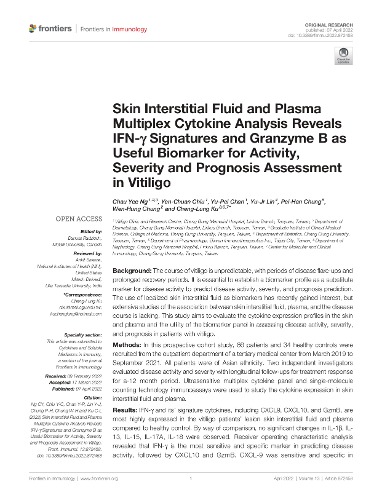研究動態
皮膚間質液和血漿多重細胞因子分析顯示IFN-γ特徵及Granzyme B作為評估白斑症活動性、嚴重性和預後的有用生物標誌物

摘 要:
**背景:** 白斑症的病程不可預測,經常出現病情惡化和長期恢復期。因此,建立一個替代標誌物來預測疾病活動性、嚴重性和預後的生物標誌物譜是至關重要的。最近,使用局部皮膚間質液作為生物標誌物引起了人們的興趣,但關於皮膚間質液、血漿與疾病過程之間關聯的廣泛研究仍然缺乏。本研究旨在評估皮膚和血漿中的細胞因子表達譜,並探討該生物標誌物面板在評估白斑症患者疾病活動性、嚴重性和預後中的實用性。 **方法:** 在這項前瞻性隊列研究中,我們從2019年3月到2021年9月期間,在一家三級醫療中心的門診部招募了86名患者和34名健康對照者。所有患者均為亞洲人種。兩名獨立的調查員對疾病活動性和嚴重性進行了評估,並進行了為期12個月的縱向隨訪以評估治療反應。使用超敏多重細胞因子面板和單分子計數技術免疫測定法研究皮膚間質液和血漿中的細胞因子表達。 **結果:** 與健康對照組相比,白斑症患者的病變皮膚間質液和血漿中IFN-γ及其標誌性細胞因子,包括CXCL9、CXCL10和顆粒酶B(GzmB)表達最高。相比之下,IL-1β、IL-13、IL-15、IL-17A和IL-18的表達沒有顯著變化。受試者工作特徵(ROC)分析顯示,IFN-γ是預測疾病活動性的最敏感和特異的標誌物,其次是CXCL10和GzmB。CXCL9在診斷白斑症疾病嚴重性方面具有敏感性和特異性。IFN-γ表達水平的下降與治療反應呈正相關。 **結論:** 在白斑症患者的病變皮膚和血漿中,IFN-γ、CXCL9、CXCL10和GzmB表達水平較高,可能作為臨床活動性、嚴重性和預後預測的生物標誌物。在所有標誌物中,IFN-γ在疾病活動性和治療反應預測方面具有最高的預測價值,支持了IFN-γ在白斑症發病機制中的關鍵作用。Background: The course of vitiligo is unpredictable, with periods of disease flare-ups and prolonged recovery periods. It is essential to establish a biomarker profile as a substitute marker for disease activity to predict disease activity, severity, and prognosis prediction. The use of localized skin interstitial fluid as biomarkers has recently gained interest, but extensive studies of the association between skin interstitial fluid, plasma, and the disease course is lacking. This study aims to evaluate the cytokine expression profiles in the skin and plasma and the utility of the biomarker panel in assessing disease activity, severity, and prognosis in patients with vitiligo. Methods: In this prospective cohort study, 86 patients and 34 healthy controls were recruited from the outpatient department of a tertiary medical center from March 2019 to September 2021. All patients were of Asian ethnicity. Two independent investigators evaluated disease activity and severity with longitudinal follow-ups for treatment response for a-12 month period. Ultrasensitive multiplex cytokine panel and single-molecule counting technology immunoassays were used to study the cytokine expression in skin interstitial fluid and plasma. Results: IFN-γ and its’ signature cytokines, including CXCL9, CXCL10, and GzmB, are most highly expressed in the vitiligo patients’ lesion skin interstitial fluid and plasma compared to healthy control. By way of comparison, no significant changes in IL-1β, IL-13, IL-15, IL-17A, IL-18 were observed. Receiver operating characteristic analysis revealed that IFN-γ is the most sensitive and specific marker in predicting disease activity, followed by CXCL10 and GzmB. CXCL-9 was sensitive and specific in diagnosing vitiligo disease severity. The decrease in IFN-γ expression level is positively correlated with the treatment response. Conclusion: IFN-γ, CXCL9, CXCL10, and GzmB are highly expressed in vitiligo patients’ lesion skin and plasma and may serve as biomarkers for the clinical activity, severity, and prognosis prediction in vitiligo patients. Among all, IFN-γ exerts the highest predictive value in disease activity and treatment response, supporting the critical role of IFN-γ in the pathogenesis of vitiligo.
近期研究動態
相關研究動態
- 先進皮膚成像系統在診斷面部色素性和炎症性疾病中的比較研究
- 從零到一:白斑症發病機理、診斷和治療的最新進展
- 針對白斑症患者中升高的IFN-γ進行人類抗IFN-γ 單株抗體生物製劑治療可抑制對黑色素細胞的直接細胞毒性
- 致病性抗IFN-γ自身抗體通過阻礙受體組裝和介導的Fc反應起作用
- 口服氨甲環酸(TA)治療白斑症合併黃褐斑的可行性
- 穩定性白斑症表皮色素移植術與自動表皮微移植術的比較研究
- 穩定型分節型與非分節型白斑症患者的表皮色素移植療效和安全性
- 高細胞分辨率全視場人工智能輔助實時光學同調斷層掃描術在白斑症評估中的可行性:一項前瞻性縱向隨訪研究
- 多發性硬化症與白斑症的關聯:系統性回顧
- PCL 膠原蛋白增生劑誘發的白斑症

